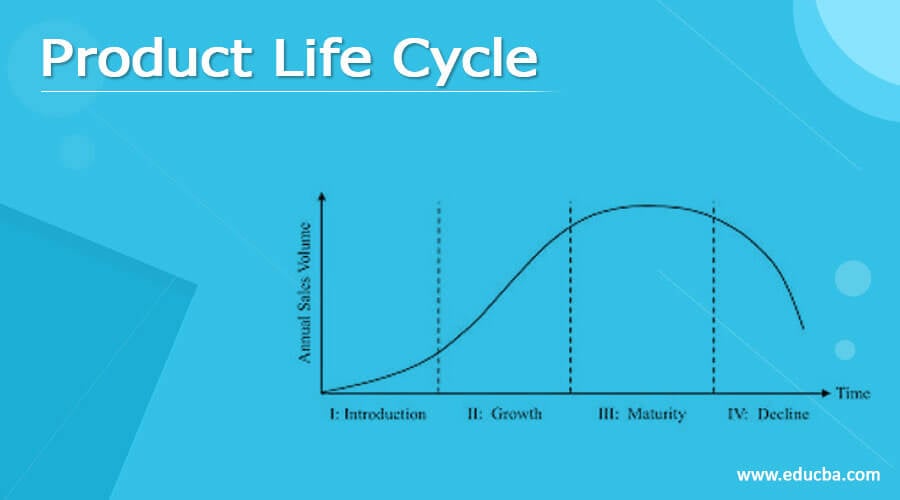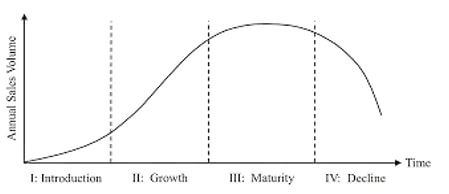Updated July 10, 2023

What is a Product Life Cycle?
The concept of the “product life cycle” encompasses the various stages a product goes through, starting from its launch and ending with its removal from the market. Generally, we can divide the product life cycle into four stages: introduction, growth, maturity, and decline. Marketing professionals and senior management teams usually use product life cycles to decide on various marketing strategies, such as escalating advertising expenses, reducing selling expansion into a new market, etc.
Stages of Product Life Cycle
Now, let us understand the four different stages in detail.
Stage I or Introduction Phase
In this stage, a product is just newly launched into the market. Here, the companies create awareness about the new products among the potential customers to develop a market for them. Typically, the following strategies are employed during this stage:
- Establish the brand and the quality level, and file for intellectual property rights, such as trademarks, patents, etc.
- Offer the product competitively to penetrate the market and quickly acquire a decent market share.
- Operate through limited distribution channels initially and then grow as consumer behavior indicates product acceptance.
- Promote the product by targeting early adopters or potential consumers.
Stage II or Growth Phase
In this stage, the product is gaining consumer acceptance and becoming popular in the market. Here, the companies emphasize building a stronger brand, and for that, they employ the following strategies:
- First, maintain product quality and gradually build additional features in them.
- Gradually increase the price and take it to a relatively higher level commensurate with the growing demand.
- Third, add more and more distribution channels to cater to the increasing market demand.
- Slowly the focus of the promotional activities is broadened to include a larger customer base.
Stage III or Maturity Phase
In this stage, the sales growth tends to become tepid or, at times, stagnant, indicating the point of market saturation for the product. Hence, in this stage, the primary objective is to defend market share and maximize profitability. Therefore, the following strategies are employed during this stage:
- Focus on adding new features to the product to stay ahead of the competition.
- Lower product prices to beat the market competition.
- Offer high incentives to distribution channels to prefer their products over competing products.
- Shift the focus of promotional activities to product differentiation.
Stage IV or Decline Phase
In this stage, the product witnesses negative sales growth. In other words, the sales experience a significant dip as demand gradually fades away. The following strategies are employed during this stage:
- First, revive product demand by incorporating new and innovative features.
- Decrease the cost of production so that profitability improves.
- If there is no feasible option to pursue, then stop production.
How is the Product Life Cycle calculated?
To formulate an excellent marketing strategy for a product, it is important to know at which stage of its current life cycle. Based on the sage of the product life cycle, a company can decide whether to increase advertising spending, order more raw materials, reduce the production cost, or pull the product off the market to let it die.
Now, the question is – how to determine the stage of the product life cycle. There are no absolute indicators for it, but some general indicators can be applied or observed over time. It will provide an indicative estimation of a product’s position in its life cycle. The general indicators are summarized in a tabular format below.
|
Indicative Features |
Product Life Cycle | |||
| Introduction | Growth | Maturity |
Decline |
|
|
Sales volume |
Low |
High | Maximum | Low |
|
Investment costs |
Maximum |
High |
Low |
Low |
|
Market competition |
Low |
Low to Medium |
High |
Maximum |
| Profitability | Low | Maximum | High |
Low |
Examples of Product Life Cycle
Now, let us look at real-life examples to understand the concept.
Typewriter: The typewriter was introduced at the end of the 19th century, and it witnessed huge growth after that, owing to its improved and innovative technology. However, the demand for typewriters faded as consumers eventually switched to computers, marking the decline of typewriters.
DVD: DVD enjoyed great demand in the late 20th century and was considered groundbreaking technology. However, the rapid demand growth of online streaming has resulted in the eventual phasing out of DVDs, which are now past their decline.
Why is the Product Life Cycle Important?
The product life cycle guides a business to determine where a product stands in its life cycle – introduction, growth, maturity, and decline. It is a flexible tool that should be used along with common sense and a general market understanding to draw the maximum value out of it. It is a very important tool that leads the marketing strategies and tweakings to make the most out of a product’s market perception.
Key Takeaways
Some of the key takeaways of the article are:
- A product life cycle refers to a product’s lifespan from its launch into the market until it is finally removed.
- It consists of four major stages – introduction, growth, maturity, and decline.
- Managers use this concept to make various business decisions, such as pricing, cost-cutting, promotion, expansion, etc.
- Introducing a newer product marks the decline of an older product in the market.
Conclusion
Typically, companies have multiple products at different product life cycle stages. So, it is important for them to proactively manage all these products as per their position in their life cycle by deploying adequate resources and suitable marketing strategies.
Recommended Articles
This is a guide to the Product Life Cycle. Here we also discuss the definition, four stages, examples, how it is calculated, and its importance. You may also have a look at the following articles to learn more –


